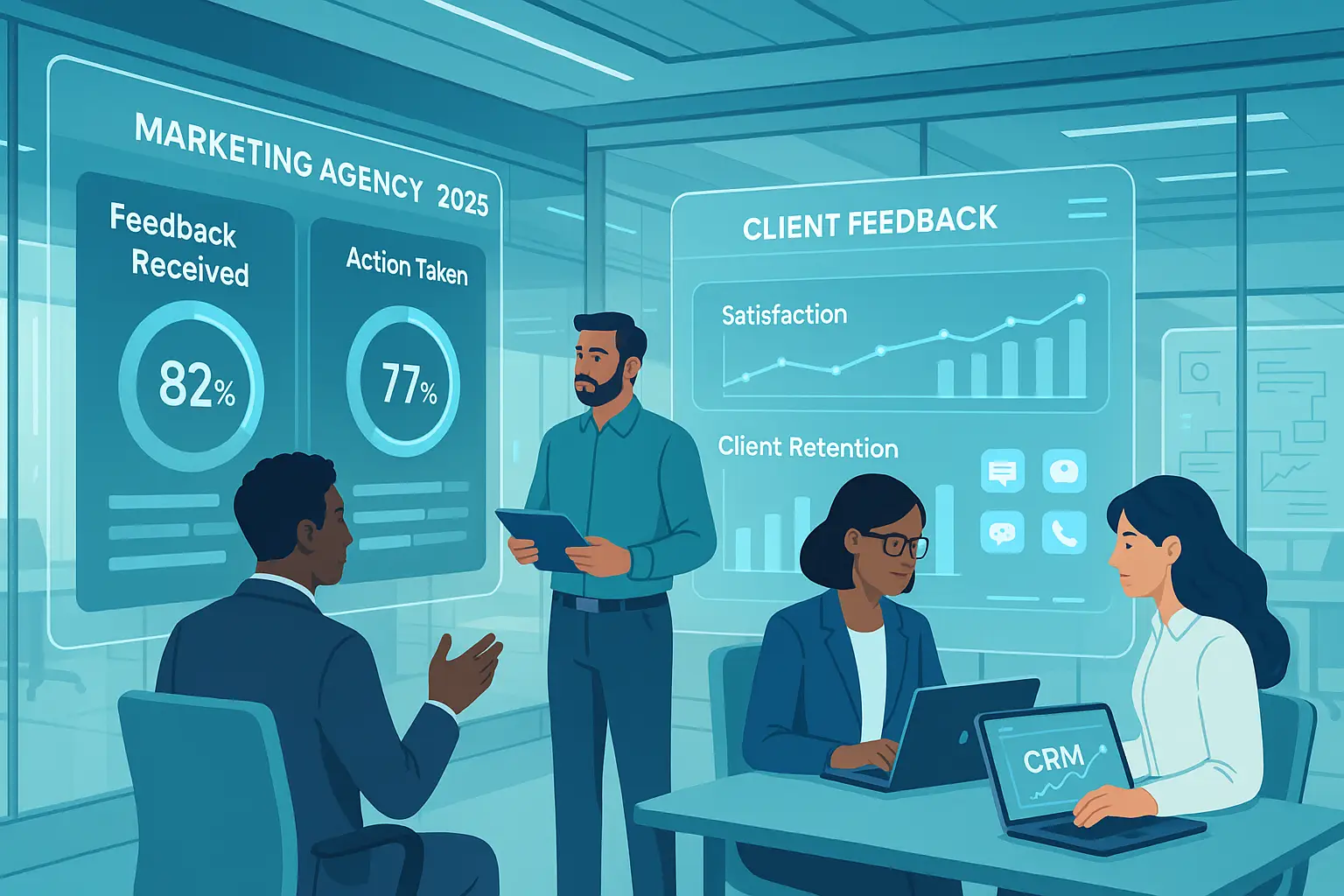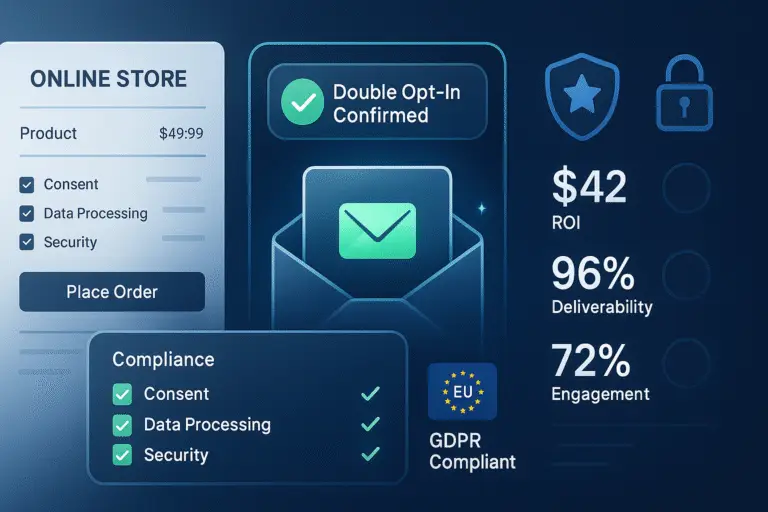Agencies looking to thrive in today’s competitive landscape need to implement effective client feedback best practices. Doing so is not just helpful. It is essential for sustainable growth and relationship building. Establishing structured client feedback processes allows agencies to find blind spots. This strengthens client relationships. Agencies can continuously refine their service offerings based on real customer insights.
We’ll cover the next areas:
- Creating systematic feedback collection methods across multiple touchpoints
- Implementing response protocols that transform feedback into actionable strategies
- Building omnichannel feedback systems that meet clients where they are
- Developing personalized engagement techniques to improve response rates
- Establishing closed-loop feedback mechanisms for continuous improvement
The Foundation of Effective Client Feedback Management
Creating a robust framework for client feedback management begins with understanding its fundamental importance to your agency’s growth. Client feedback strategies aren’t just about collecting opinions—they’re about gathering actionable intelligence that drives meaningful change. When implemented correctly, a comprehensive client feedback process becomes your agency’s most valuable asset for service refinement and client retention.
Successful agencies recognize that feedback collection shouldn’t be limited to annual surveys or end-of-project assessments. Instead, they create multiple touchpoints throughout the client journey, allowing for both formal and informal feedback opportunities. This approach helps capture insights when they’re most relevant and provides a more complete picture of the client experience.
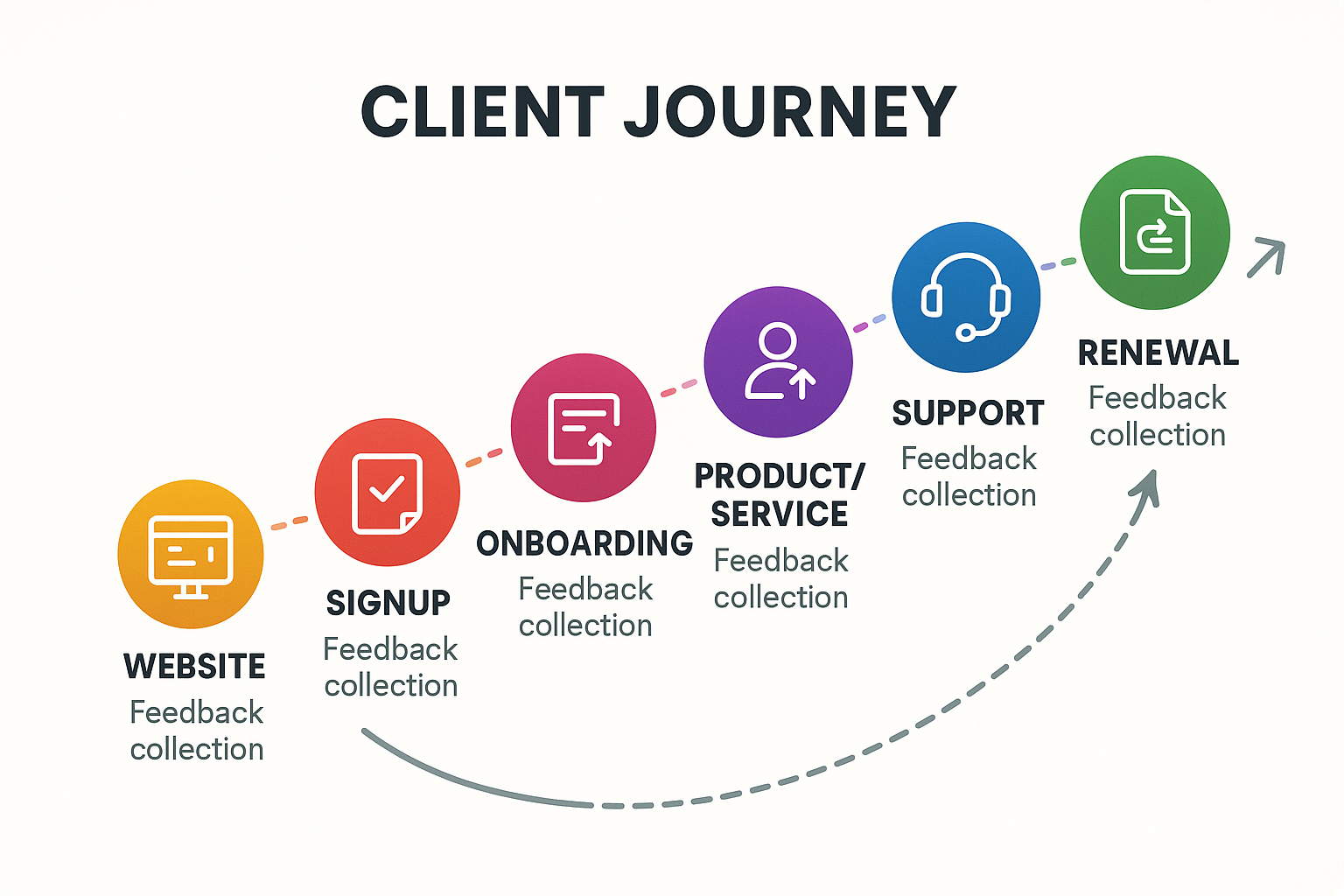
Choosing the Right Feedback Collection Methods
When selecting which method is commonly used to gather customer feedback, consider your clients’ preferences and communication styles. Different feedback collection techniques yield different types of insights, and the most successful agencies employ a strategic combination of methods.
For structured quantitative data, client feedback surveys remain invaluable. These can include:
- Net Promoter Score (NPS) surveys to measure client loyalty
- Customer Satisfaction (CSAT) surveys to evaluate specific interactions
- Customer Effort Score (CES) surveys to assess ease of working with your agency
- Project completion assessments to gather comprehensive feedback
For qualitative insights, consider implementing regular check-in calls, feedback workshops, or client advisory boards. These methods foster deeper conversations and often reveal nuanced perspectives that surveys might miss. The key is matching the feedback method to the specific information you need at each stage of the client relationship.
Omnichannel Feedback Collection Strategies
Modern client feedback best practices emphasize meeting clients where they are through omnichannel feedback collection. This approach recognizes that clients have different communication preferences and ensures no valuable feedback falls through the cracks.
A truly omnichannel approach might include:
- In-app or website feedback widgets for digital services
- Email surveys for formal assessments
- SMS for quick pulse checks
- Social media monitoring for unsolicited feedback
- Video calls for in-depth discussions
The goal isn’t to implement every possible channel but to identify which combination works best for your specific client base. This tailored approach demonstrates that you value client input and respect their time and preferences.

Maximizing Client Feedback Response Rates
Even the most well-designed feedback program fails if clients don’t participate. Improving your feedback response rate requires strategic planning and thoughtful execution. Start by being transparent about why you’re collecting feedback and how you’ll use it to improve their experience.
Timing plays a crucial role in response rates. Request feedback at natural milestones or after significant interactions, when the experience is fresh in clients’ minds. Avoid overwhelming clients with too many requests, which can lead to feedback fatigue and lower participation.
Personalized client engagement significantly impacts response rates. Customize your requests based on the client’s history with your agency, referencing specific projects or interactions to demonstrate that this isn’t a generic process. When clients see that you’ve put thought into your request, they’re more likely to reciprocate with thoughtful feedback.
| Feedback Method | Best Timing | Average Response Rate |
|---|---|---|
| Post-project survey | Within 48 hours of completion | 45-60% |
| Quarterly check-in calls | Mid-quarter, scheduled in advance | 70-85% |
| In-app feedback | During active platform usage | 15-25% |
| NPS surveys | After 3 months of service | 30-40% |
Handling and Responding to Client Feedback
How to handle client feedback effectively distinguishes leading agencies from the rest. The way you respond to feedback—especially critical input—can either strengthen or damage client relationships. Develop a systematic approach for acknowledging, analyzing, and acting on the feedback you receive.
When faced with negative feedback from a client, resist the urge to become defensive. Instead:
- Thank the client for their honesty
- Acknowledge their concerns without making excuses
- Ask clarifying questions to fully understand the issue
- Present a clear action plan with specific steps and timelines
- Follow up to ensure the solution met their expectations
For positive feedback, don’t simply file it away. Use it to reinforce successful approaches, recognize team members, and identify best practices that can be applied more broadly across your agency.
Creating a Closed Client Feedback Loop
A client feedback loop transforms sporadic input into a continuous improvement system. This structured approach ensures that feedback doesn’t just get collected but actually drives meaningful change within your organization.
The complete feedback loop includes:
- Collection: Gathering input through appropriate channels
- Analysis: Identifying patterns and priority issues
- Action Planning: Developing specific responses to feedback
- Implementation: Making necessary changes
- Communication: Informing clients about actions taken
- Follow-up: Verifying that changes addressed the original concern
Closing the feedback loop by communicating what actions you’ve taken based on client input is particularly powerful. When clients see their feedback translated into tangible improvements, it builds trust and encourages future participation in your feedback program.
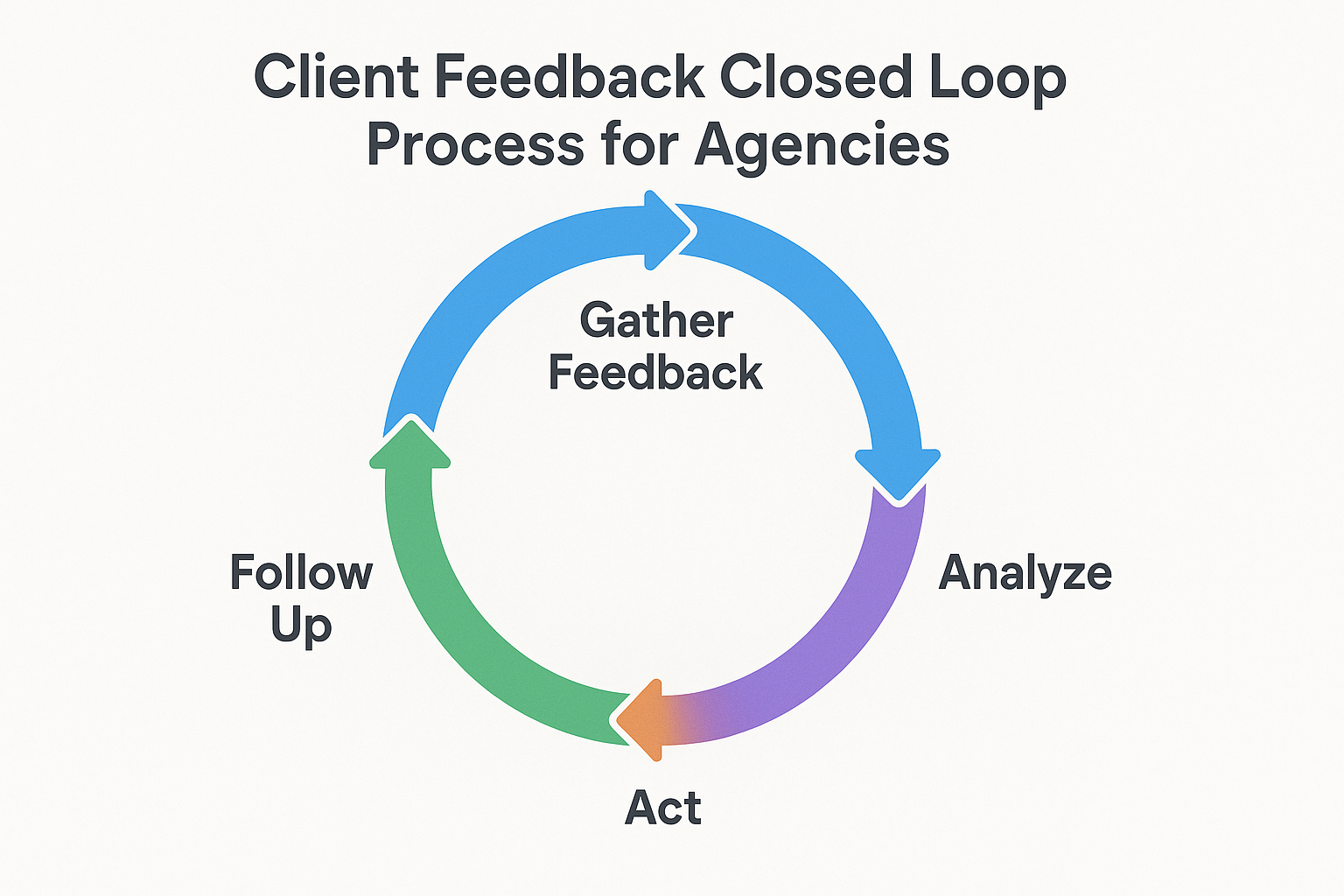
Using Feedback to Drive Strategic Improvements
Beyond addressing individual client concerns, comprehensive feedback analysis helps identify broader patterns that can inform your agency’s strategic decisions. Regular analysis sessions with your leadership team can turn accumulated feedback into actionable insights about service offerings, operational processes, or market positioning.
Create a system for categorizing feedback based on themes, urgency, and potential impact. This structured approach helps prioritize improvements and allocate resources effectively. Remember that not all feedback requires immediate action—some might indicate longer-term trends that should inform your strategic planning.
Following Up Without Being Pushy
Learning how to follow up with a client without being pushy is essential for maintaining healthy agency-client relationships. Follow-up communications should demonstrate your commitment to addressing their concerns without creating additional pressure or demands on their time.
Space your follow-ups appropriately, respecting the client’s schedule and communication preferences. A good rule of thumb is to provide updates at meaningful milestones rather than arbitrary intervals. When you do reach out, focus on what’s been accomplished based on their feedback rather than asking for additional input.
Be specific about what actions you’ve taken in response to their feedback:
- “Based on your suggestion about project timelines, we’ve implemented a new scheduling system”
- “The communication issue you identified helped us revise our client update protocol”
- “Your feedback about our deliverable format led us to create new templates that we’re now using with all clients”
This approach demonstrates that you valued their input enough to take concrete action, reinforcing their importance to your agency.
Encouraging Honest Feedback in Agency Relationships
Creating an environment where clients feel comfortable providing honest feedback requires intentional effort. Many clients, especially in ongoing agency relationships, hesitate to express dissatisfaction for fear of damaging the working relationship or being labeled as “difficult.”
To encourage honest client feedback in agency relationships:
- Demonstrate openness by asking specific, non-leading questions
- Respond positively to critical feedback when it’s offered
- Create anonymous feedback options for sensitive topics
- Set expectations early that feedback is welcome and valued
- Show vulnerability by acknowledging your agency’s opportunities for growth
When clients see that constructive criticism leads to positive changes rather than defensive reactions, they’re more likely to provide the candid insights that truly drive improvement.
Leveraging Technology for Feedback Management
Modern feedback management tools can dramatically improve how agencies collect, analyze, and act on client input. The right technology stack supports personalized engagement while reducing the administrative burden of feedback management.
Consider implementing:
- CRM systems with integrated feedback tracking
- Survey platforms that offer customization and advanced analytics
- Text analysis tools to identify patterns in qualitative feedback
- Client portals with built-in feedback mechanisms
- Project management software that incorporates feedback into workflows
The goal isn’t technology for its own sake but tools that make feedback collection more seamless for clients and feedback management more efficient for your team.
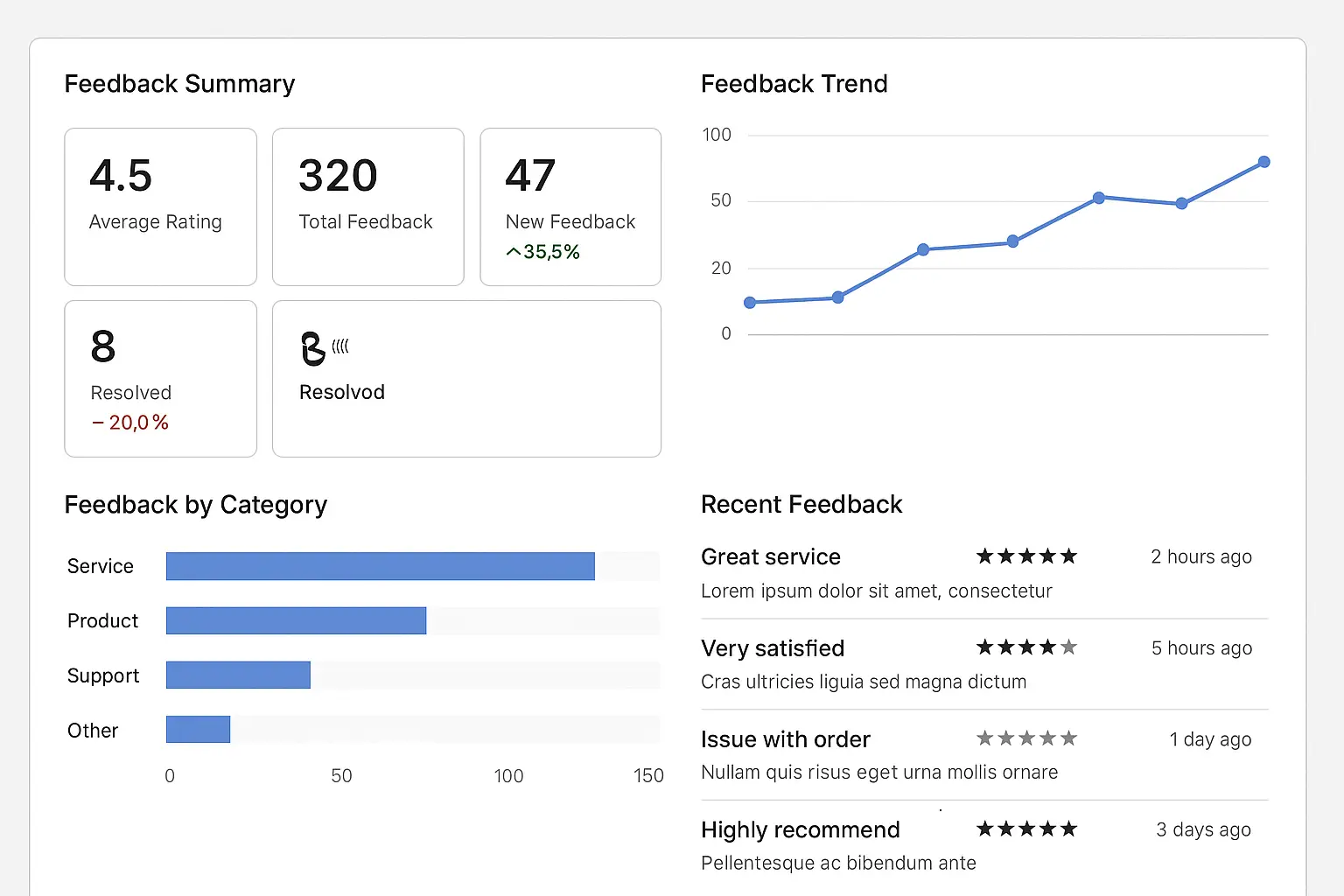
Measuring the Impact of Your Feedback Program
To ensure your client feedback strategies deliver real value, establish client satisfaction metrics that gauge both the effectiveness of your feedback program and the resulting improvements to your services.
Track metrics such as:
- Response rates to feedback requests
- Changes in NPS or CSAT scores over time
- Time to resolution for issues identified through feedback
- Client retention rates
- Percentage of feedback that leads to actionable changes
Regularly review these metrics with your leadership team, looking for trends that indicate the effectiveness of your feedback program and identifying areas where your approach might need refinement.
Conclusion: From Feedback to Forward Motion
Implementing client feedback best practices isn’t a one-time project but an ongoing commitment to client-centered improvement. The most successful agencies integrate feedback collection, analysis, and response into their core operations, treating client input as their most valuable source of insights.
The ultimate goal isn’t just to collect feedback. It’s to create a culture where feedback drives continuous improvement. This culture strengthens client relationships. By implementing the strategies outlined in this article, your agency can transform client feedback. It changes an occasional check-in into a powerful engine for growth. This engine also supports retention and reputation building.
I’d love to hear how you’ve implemented feedback systems in your agency. What approaches have yielded the most valuable insights?
Discover more from SaaSPrism
Subscribe to get the latest posts sent to your email.

